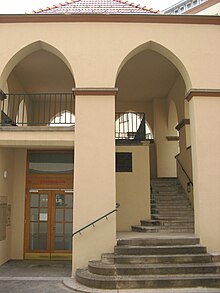Karl Krist
Karl Alois Krist (born October 25, 1883 in Vienna ; † February 4, 1941 there ) was an Austrian architect .
Life
Karl Krist, whose date of birth is incorrectly given in several reference works, was the son of the carpenter Johann Krist and his wife Marie Cech. After graduating from the Staatsgewerbeschule Krist began his studies at the Technical University of Vienna , but broke off in 1913 and attended Friedrich Ohmann's master class at the Academy of Fine Arts in Vienna from 1913 to 1915 , where he also won several prizes (Olbrich Prize, Hagenmüller Prize ) received. Krist made trips to Peterwardein, Breslau, Agram and other cities.
After graduating, he worked for the municipal department 22 of the municipality of Vienna. At the same time, he also owned a private office, which built workshops and carried out conversions in particular for the company Gräf & Stift .
Since 1921 he was involved in settlement projects (settlements Lissenwasser, Schwarzlackenau, Jägermais, Baumanngasse with adjoining municipal housing 21., Josef-Baumann-Gasse 65-67) and was soon one of the most productive architects in municipal housing. The Dr.-Franz-Klein-Hof (1924/25, 221 apartments), the Anton-Schrammel-Hof (1925/26, 257 apartments), the Liebknechthof (1926/27, 428 apartments) and the smaller residential complexes come from him Rögergasse 6 (1923/24, 42 apartments) and Hetzendorfer Straße 157–161 (1927, 49 apartments).
After Gessner won a competition between Krist, Hubert Gessner and Robert Oerley for the garden city Jedlesee (today Karl-Seitz-Hof) in 1925 , Krist and Oerley received the order in 1926 to plan another garden city, the residential complex "Am Wienerberg - Spinner on the Cross ", later called George Washington Hof . The design of the birch, lilac and maple courtyards comes from the construction groups named after the tree planting of the central courtyards. The nearby residential complex Eschenallee 1–9 (1931/32, 120 apartments) was also built according to plans by Krist.
In 1938 Krist was forced into retirement by the National Socialists.
Works
- Jägermais settlement, Vienna 22, (1921)
- Gartenheim housing estate, Vienna 22 (1921–23)
- Schwarzlackenau I Settlement , Vienna 21 (1922)
- Schwarzlackenau II settlement, Vienna 21 (1922–24)
- Lissenwasser Settlement, Vienna 21 (1922–24)
- Small settlement Josef-Baumann-Gasse, Vienna 21 (from 1923)
- Housing complex Rögergasse 6, Vienna 9 (1923–24)
- Housing complex Dr.-Franz-Klein-Hof , Vienna 11 (1924–1925)
- Housing complex Anton-Schrammel-Hof , Vienna 11 (1925–26)
- Liebknechthof residential complex , Vienna 12 (1926–27)
- George Washington Hof residential complex, Vienna 10 (1927–30), together with Robert Oerley
- Housing complex Josef Baumann-Gasse 65–67, Vienna 21 (1929–30)
- Residential complex Eschenallee 1–9, Vienna 10 (1931–32)
- Official apartments at Billrothstrasse 58–62, Vienna 19 (1936–38)
- Residential buildings Pyrkergasse 6–8, Vienna 19 (around 1936)
literature
- Bertha Blaschke, Luise Lipschitz: Architecture in Vienna 1850 to 1930: Historicism, Art Nouveau, Objectivity , Springer-Verlag, Vienna 2003 ( ISBN 3-211-83736-1 ), p. 216–217: George-Washington-Hof (Karl Krist , Robert Örley)
Web links
- Karl Krist. In: dasrotewien.at - Web dictionary of the Viennese social democracy. SPÖ Vienna (Ed.)
- Karl Krist. In: Architects Lexicon Vienna 1770–1945. Published by the Architekturzentrum Wien . Vienna 2007.
| personal data | |
|---|---|
| SURNAME | Krist, Karl |
| ALTERNATIVE NAMES | Krist, Karl Alois |
| BRIEF DESCRIPTION | Austrian architect |
| DATE OF BIRTH | October 25, 1883 |
| PLACE OF BIRTH | Vienna |
| DATE OF DEATH | February 4, 1941 |
| Place of death | Vienna |
